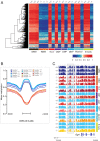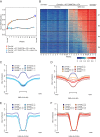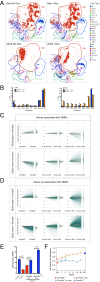Remethylation of Dnmt3a-/- hematopoietic cells is associated with partial correction of gene dysregulation and reduced myeloid skewing
- PMID: 31996479
- PMCID: PMC7022185
- DOI: 10.1073/pnas.1918611117
Remethylation of Dnmt3a-/- hematopoietic cells is associated with partial correction of gene dysregulation and reduced myeloid skewing
Abstract
Mutations in the DNA methyltransferase 3A (DNMT3A) gene are the most common cause of age-related clonal hematopoiesis (ARCH) in older individuals, and are among the most common initiating events for acute myeloid leukemia (AML). The most frequent DNMT3A mutation in AML patients (R882H) encodes a dominant-negative protein that reduces methyltransferase activity by ∼80% in cells with heterozygous mutations, causing a focal, canonical DNA hypomethylation phenotype; this phenotype is partially recapitulated in murine Dnmt3a-/- bone marrow cells. To determine whether the hypomethylation phenotype of Dnmt3a-/- hematopoietic cells is reversible, we developed an inducible transgene to restore expression of DNMT3A in transplanted bone marrow cells from Dnmt3a-/- mice. Partial remethylation was detected within 1 wk, but near-complete remethylation required 6 mo. Remethylation was accurate, dynamic, and highly ordered, suggesting that differentially methylated regions have unique properties that may be relevant for their functions. Importantly, 22 wk of DNMT3A addback partially corrected dysregulated gene expression, and mitigated the expansion of myeloid cells. These data show that restoring DNMT3A expression can alter the epigenetic "state" created by loss of Dnmt3a activity; this genetic proof-of-concept experiment suggests that this approach could be relevant for patients with ARCH or AML caused by loss-of-function DNMT3A mutations.
Keywords: DNA methylation; DNA methyltransferase; gene expression; hematopoiesis.
Copyright © 2020 the Author(s). Published by PNAS.
Conflict of interest statement
Competing interest statement: T.J.L. is engaged in a scientific collaboration with Rigel Pharmaceuticals to develop drugs that inhibit the function of the DNMT3A R882H mutation. He has received two honoraria from Rigel Pharmaceuticals to give presentations at their company in South San Francisco, CA. None of this work is described in this paper.
Figures






Similar articles
-
Rapid and accurate remethylation of DNA in Dnmt3a-deficient hematopoietic cells with restoration of DNMT3A activity.Sci Adv. 2024 Feb 2;10(5):eadk8598. doi: 10.1126/sciadv.adk8598. Epub 2024 Jan 31. Sci Adv. 2024. PMID: 38295174 Free PMC article.
-
CpG Island Hypermethylation Mediated by DNMT3A Is a Consequence of AML Progression.Cell. 2017 Feb 23;168(5):801-816.e13. doi: 10.1016/j.cell.2017.01.021. Epub 2017 Feb 16. Cell. 2017. PMID: 28215704 Free PMC article.
-
Functional and epigenetic phenotypes of humans and mice with DNMT3A Overgrowth Syndrome.Nat Commun. 2021 Jul 27;12(1):4549. doi: 10.1038/s41467-021-24800-7. Nat Commun. 2021. PMID: 34315901 Free PMC article.
-
[Functional role of DNMT3A mutation in acute myeloid leukemia].Rinsho Ketsueki. 2018;59(5):602-610. doi: 10.11406/rinketsu.59.602. Rinsho Ketsueki. 2018. PMID: 29877252 Review. Japanese.
-
AML-Associated Mutations in DNA Methyltransferase DNMT3A.Biochemistry (Mosc). 2021 Mar;86(3):307-318. doi: 10.1134/S000629792103007X. Biochemistry (Mosc). 2021. PMID: 33838631 Review.
Cited by
-
Impact of Epigenomic Hypermethylation at TP53 on Allogeneic Hematopoietic Cell Transplantation Outcomes for Myelodysplastic Syndromes.Transplant Cell Ther. 2021 Aug;27(8):659.e1-659.e6. doi: 10.1016/j.jtct.2021.04.027. Epub 2021 May 13. Transplant Cell Ther. 2021. PMID: 33992829 Free PMC article.
-
Somatic Dnmt3a inactivation leads to slow, canonical DNA methylation loss in murine hematopoietic cells.iScience. 2022 Mar 3;25(4):104004. doi: 10.1016/j.isci.2022.104004. eCollection 2022 Apr 15. iScience. 2022. PMID: 35313694 Free PMC article.
-
Rapid and accurate remethylation of DNA in Dnmt3a-deficient hematopoietic cells with restoration of DNMT3A activity.Sci Adv. 2024 Feb 2;10(5):eadk8598. doi: 10.1126/sciadv.adk8598. Epub 2024 Jan 31. Sci Adv. 2024. PMID: 38295174 Free PMC article.
-
Alterations to DNMT3A in Hematologic Malignancies.Cancer Res. 2021 Jan 15;81(2):254-263. doi: 10.1158/0008-5472.CAN-20-3033. Epub 2020 Oct 21. Cancer Res. 2021. PMID: 33087320 Free PMC article. Review.
-
Non-genetic heterogeneity, altered cell fate and differentiation therapy.EMBO Mol Med. 2021 Mar 5;13(3):e12670. doi: 10.15252/emmm.202012670. Epub 2021 Feb 8. EMBO Mol Med. 2021. PMID: 33555144 Free PMC article. Review.
References
Publication types
MeSH terms
Substances
Grants and funding
LinkOut - more resources
Full Text Sources

